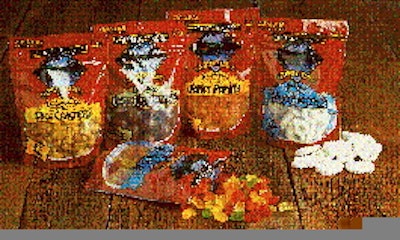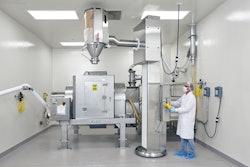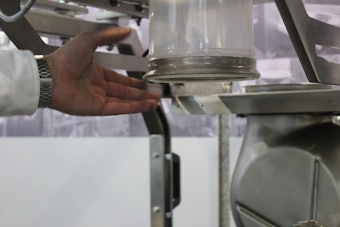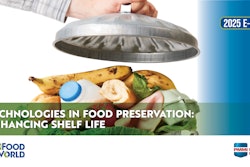Golden Stream Quality Foods president and CEO Stephen Farber reaches into his desk drawer and pulls out a letter from a consumer. She writes that she's delighted with the quality of the product in the company's new stand-up pouch. She compliments the resealable zipper, and how easy it is to discard the pouch, believing that its small size and light weight must make it an environmentally smart buy.
The letter is in response to the company's introduction last November of stand-up pouches for 30 of its products. The Fishers, IN-based candy and snack food producer's stand-up pouch-packed products are now sold in some 4귔 retail outlets in nearly 20 states. Within the next year, Farber expects distribution of the products will be nationwide.
Retailers like the stand-up pouches, Farber says, "because they can be displayed both on the shelf and on pegs." Consumers, it appears, are buying more pouches as they become more familiar with them for a variety of products (see Packaging World, April '97, p. 2).
First user of machine
The packs are currently produced at rates of 55 to 60 per minute, nearly 15 hours/day, six days/week, on an RPM L horizontal rotary form/fill/seal packaging machine from Klockner Packaging Machinery (Sarasota, FL). The machine produces Klockner's Delta-Pac(TM) gusseted pouch.
Klockner reports that Golden Stream is the first commercial user of the "L" version of the intermittent-motion hf/f/s machine. The "L" designation refers to "larger format" in that it produces pouch sizes up to 91/2" wide x 121/2" tall. That's larger than the RPM 100, which accommodates pouches to 71/4" x 10". Golden Stream's pouches currently measure 73/4" x 8", though larger sizes are likely.
Cutting changeover
Using the same size pouch for all products takes one key variable out of the changeover equation for Golden Stream. To further reduce potential downtime for changeovers, the company has done its homework. Rather than filling products in a haphazard order, Golden Stream schedules like products to succeed one another.
For example, spicy mixes might be filled one after another. Between the different mix products, Golden Stream uses compressed air to blow out product from certain areas of the machine such as scales, buckets and other product-contact parts. After each of these similar mixes are filled, a more complete washdown is performed on the entire machine before Golden Stream fills another type of product, such as chocolate candies.
"We're a smaller company, so we've got to get the biggest bang for our buck," notes Jim Greskamp, plant engineer. "We're trying to smarten up when it comes to preparing and running product on the machine. For example, when we run gummy bears, we store them in the cold room and fill them when it's not too humid outside. This way we can prevent sticking and fill them more efficiently."
Greskamp "re-engineered" a "duckbill" device that helps to fully open the pouch. Product is filled through the duckbill. When the fill is complete the duckbill retracts out of the pouch in order to repeat the process.
"From product to product, all we really have to do for a changeover is to change the film, and adjust the stop/open position of the duckbill," says Greskamp. "We wanted to use the same duckbill for all of the products we fill into stand-up pouches, without needing to make a part changeover for every product."
The challenge was met by programming both the opening and closing of the duckbill and the filling speed for each particular product into the control system. Yogurt-covered pretzels, for example, are difficult to fill because they're light, yet they're one of the larger-sized items. Therefore, they fill up most of the pouch. To accommodate them, the duckbill must open wide and be "finessed" back out of the pouch so that within milliseconds, it's ready to open and fill the next pouch.
Sunflower seeds, on the other hand, are smaller and easier to fill. In this instance, the duckbill doesn't need to open as far as it does with pretzels. Because of that, the duckbill can be retracted from the top of the pouch without first being closed.
Pouch packs sales appeal
Fill weights range from 4 to 12 oz per bag, depending on product density. The stand-up pouches are produced from rollstock supplied by Printpack (Atlanta, GA). The 3.5-mil structure includes a 3-mil sealant layer of linear low-density polyethylene that's adhesive-laminated to a 48-ga polyester coated with polyvinylidene chloride for added moisture barrier. The polyester is reverse-printed flexographically in eight colors.
According to Printpack, the thick LLDPE provides rigidity that helps the pouch stand up. The material adds moisture barrier as well. Oxygen barrier comes from the PVDC-coated polyester portion of the structure.
Moisture vapor transmission rate is 0.24 g/m2 at 100°F at 90% relative humidity; oxygen transmission rate is 0.6 cc/m2 at 100° F at 0% RH, while approximate haze value is 12.
Besides its barrier characteristics, the stand-up pouch lends sales punch. A vibrant red color dominates every pack. A product viewing window, handsome logo and easy-to-see reference to the resealable zipper combine to give the pack an impressive shelf presence.
Clearly, this pack's eye appeal is so good, it's replacing the company's previous twist-tie bags. The new pouches also enjoy a dramatic graphic advantage over the zippered bags that Golden Stream introduced about two years ago (see PW, April '95, p. 30). The zippers for those bags are applied in-line on a vertical form/fill/seal machine.
Farber says the material for each zippered pouch costs Golden Stream about 51/2¢. That's about 1/2¢ more than the previous combined costs of the twist tie, film and labor to close the twist tie. The added cost, he says, "is more than made up for in added product sales appeal.
"Previously, our bags looked more like 'me-too' packaging, and they really didn't stand out in terms of graphics and package features," admits Farber. "This stand-up pouch grabs the consumer's attention."
He notes that while "our past bags had reclosable zippers, the zippers were positioned in the long dimension, and were sold like cheese packs. We felt that the stand-up feature with the resealable zipper on the short dimension of the pouch can be merchandised in a much more appealing fashion."
The shorter zipper also reduces material costs compared to the zipper produced on vf/f/s equipment at Golden Stream.
Farber says, "the pouch fit our marketing concepts perfectly. And it makes it easier for retailers to display them on either pegs or hooks."
Sealing steps
On the RPM L, pouch forming begins as the 183/4"-wide rollstock unwinds from a hydraulically operated unwind stand at the front end of the hf/f/s machine. The film continues through a series of dancer rollers. An edge-guide assembly equipped with fiber-optic sensors helps maintain the proper film position.
As the film unwinds toward a forming plow, a punch mechanism punches two circular holes along the center of the film. When the film moves over the plow, it is folded in half vertically, with the holes helping to form the bottom gusset.
From an unwind stand positioned above the film, the low-density polyethylene zipper profile material is fed down through a series of tensioning rollers, then delivered in a horizontal plane between the folded film, near its top. The E 264 zipper material is supplied by MiniGrip/Zip Pak (Manteno, IL).
The materials are pulled through the heat sealing area of the RPM L machine by servo-driven driving rollers. At the first sealing station, a vertical side "preseal" is made. The preseal extends from just below the zipper area to the bottom of the bag.
As the material indexes forward, it passes along a "splitter bar" that separates the male and female parts of the zipper. Subsequently, the male portion of the zipper is sealed to one panel of the folded pouch material, the female portion to the other. The gusset seal is also made at this station.
A permanent side seal is then made. Golden Stream programs this seal for a thicker material, increasing the dwell time so that this seal is stronger than the preseal. Unlike the preseal, this seal is complete from the top to the bottom of the bag.
The sealed bag then goes through an ultrasonic sealing station that side-seals the thick zipper material at the two side edges to approximately the same thickness of the pouch material itself. This ultrasonic seal is made by a unit supplied by Branson Ultrasonics (Danbury, CT). Chilled water is used to quickly cure the seal area.
Subsequently, a six-digit date code is hot-stamped onto the bottom of the front panel by a printer from Norwood Marking Systems (Downers Grove, IL). Coded shelf life ranges up to two years from the date the product is packed.
A cut above
A small notch is then cut into both sides of the material, just above the zipper area, but below the top seal. "This allows an elderly person or a child to easily open the pouch from either side," notes Greskamp. "And after it's opened, the consumer can still see the Golden Stream name at the top of the pouch." The words "tear here" appear on an image of a zipper tab to make it easy for consumers to see where to open the pouch.
The printed, notched material is then cut from the web into an individual pouch. "We use a registration Smarteye® that communicates with the machine's software to find the registration mark," he says. The Smarteye component is supplied by Tri-Tronics (Tampa, FL). "It's so accurate that you can literally cut your registration mark right down the center every single time. It's a fabulous little device."
Once the material is cut, a clamp takes each pouch and transfers it to a set of grippers that carry the pouch through eight stations on a rotary filling turret. Golden Stream uses a nearly constant flow of nitrogen at several points within the turret to displace oxygen, and to help extend product shelf life.
Rotary filling
At the first station, two small vacuum cups help open the pouch, one from the front pouch panel, another from the back. The pouch then indexes clockwise, with air jets supplying a burst of nitrogen to fully open the pouch. At position three, a forming plunger mounted to a vertical pushrod moves downward, contacting the top of the pouch to help "shape" the opening for filling. The pushrod/plunger then retracts.
At the next station, the duckbill enters the bag to accommodate filling. Product is transferred from processing areas in large hoppers. A hopper is automatically hoisted into the air and turned so that product dumps into a bulk handling elevator system. The system's pivoting buckets carry product up about 15 feet before the buckets pivot, dispensing product into the hopper of a computerized 14-head combination net weigh scale system.
The scaling system is manufactured by Yamato, represented in the U.S. by Hayssen (Duncan, SC). The 14-head system uses two sets of buckets. A top set of buckets feeds product into a bottom set of weigh buckets. The latter buckets include cells that weigh the amount of product within each particular cell. That information is relayed to a computer. The computer then selects the combination of scales whose weights contain the most precise amount of product to meet the desired fill weight.
Usually four to six buckets are used for each dump. Product descends through a chute, and the duckbill, and down into the open pouch. The opening of the duckbill and a blast of nitrogen help to open the top of the pouch to speed filling.
Filled pouches index to station five, where a vibrating platform helps to settle the product. That creates more room for the machine to top seal the pouch. Top sealing is done at the next station. With some products, air is evacuated, though the introduction of nitrogen within the turret area displaces most of the oxygen, according to Greskamp.
The sealed pouch passes cooling bars before a pickoff mechanism places the pouch on a discharge conveyor for manual case packing. Operators place 12 packs into a corrugated case, with all pouches standing their base.
All the right moves
"We've been extremely pleased with the RPM L," says Greskamp, who was influential in selecting the machine after a decision was first made to package in stand-up pouches.
The ultimate decision to buy the RPM L was based on the company's belief that a U.S. supplier could provide more responsive service and readily have parts available when necessary. "We also felt that Klockner's reputation for craftsmanship and use of technology was in their favor," adds Greskamp.
Golden Stream expects to add more hf/f/s machinery in the future. "When we add them, of course, depends on the success of our products in the market," notes Greskamp. The current packs range in price from $1.29 to $2.99.
Based on the initial market response the future looks bright. Farber says, "We'll definitely be needing another packaging machine to meet our volume, and to test larger-sized pouches. And the machine will definitely be another Klockner."
Golden Stream is also looking at the possibility of installing case packing equipment to automate labor-intensive manual packing. Just when will sales justify the purchase of the additional RPM L and case packing machinery? Stay tuned. . . .



















